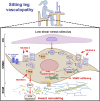Sitting leg vasculopathy: potential adaptations beyond the endothelium
- PMID: 38241008
- PMCID: PMC11221807
- DOI: 10.1152/ajpheart.00489.2023
Sitting leg vasculopathy: potential adaptations beyond the endothelium
Abstract
Increased sitting time, the most common form of sedentary behavior, is an independent risk factor for all-cause and cardiovascular disease mortality; however, the mechanisms linking sitting to cardiovascular risk remain largely elusive. Studies over the last decade have led to the concept that excessive time spent in the sitting position and the ensuing reduction in leg blood flow-induced shear stress cause endothelial dysfunction. This conclusion has been mainly supported by studies using flow-mediated dilation in the lower extremities as the measured outcome. In this review, we summarize evidence from classic studies and more recent ones that collectively support the notion that prolonged sitting-induced leg vascular dysfunction is likely also attributable to changes occurring in vascular smooth muscle cells (VSMCs). Indeed, we provide evidence that prolonged constriction of resistance arteries can lead to modifications in the structural characteristics of the vascular wall, including polymerization of actin filaments in VSMCs and inward remodeling, and that these changes manifest in a time frame that is consistent with the vascular changes observed with prolonged sitting. We expect this review will stimulate future studies with a focus on VSMC cytoskeletal remodeling as a potential target to prevent the detrimental vascular ramifications of too much sitting.
Keywords: cytoskeletal remodeling; endothelium-independent vasodilation; inward remodeling leg vascular dysfunction; prolonged sitting; vascular smooth muscle.
Conflict of interest statement
No conflicts of interest, financial or otherwise, are declared by the authors.
Figures








Similar articles
-
Prolonged sitting-induced leg endothelial dysfunction is prevented by fidgeting.Am J Physiol Heart Circ Physiol. 2016 Jul 1;311(1):H177-82. doi: 10.1152/ajpheart.00297.2016. Epub 2016 May 27. Am J Physiol Heart Circ Physiol. 2016. PMID: 27233765 Free PMC article.
-
Prolonged sitting leg vasculopathy: contributing factors and clinical implications.Am J Physiol Heart Circ Physiol. 2017 Oct 1;313(4):H722-H728. doi: 10.1152/ajpheart.00326.2017. Epub 2017 Jul 21. Am J Physiol Heart Circ Physiol. 2017. PMID: 28733451 Free PMC article. Review.
-
Endothelial dysfunction following prolonged sitting is mediated by a reduction in shear stress.Am J Physiol Heart Circ Physiol. 2016 Mar 1;310(5):H648-53. doi: 10.1152/ajpheart.00943.2015. Epub 2016 Jan 8. Am J Physiol Heart Circ Physiol. 2016. PMID: 26747508 Free PMC article.
-
An acute bout of prolonged sitting blunts popliteal endothelium-independent dilation in young, healthy adults.J Appl Physiol (1985). 2023 Mar 1;134(3):521-528. doi: 10.1152/japplphysiol.00712.2022. Epub 2023 Jan 19. J Appl Physiol (1985). 2023. PMID: 36656984
-
The Acute Effects of Prolonged Uninterrupted Sitting on Vascular Function: A Systematic Review and Meta-analysis.Med Sci Sports Exerc. 2022 Jan 1;54(1):67-76. doi: 10.1249/MSS.0000000000002763. Med Sci Sports Exerc. 2022. PMID: 34334722
Cited by
-
Healthy Behavior for Preventing Cognitive Disability in Older Persons.Int J Environ Res Public Health. 2025 Feb 12;22(2):262. doi: 10.3390/ijerph22020262. Int J Environ Res Public Health. 2025. PMID: 40003487 Free PMC article. Review.
References
-
- Tremblay MS, Aubert S, Barnes JD, Saunders TJ, Carson V, Latimer-Cheung AE, Chastin SFM, Altenburg TM, Chinapaw MJM; SBRN Terminology Consensus Project Participants. Sedentary Behavior Research Network (SBRN) - terminology consensus project process and outcome. Int J Behav Nutr Phys Act 14: 75, 2017. doi:10.1186/s12966-017-0525-8. - DOI - PMC - PubMed
-
- Dempsey PC, Biddle SJH, Buman MP, Chastin S, Ekelund U, Friedenreich CM, Katzmarzyk PT, Leitzmann MF, Stamatakis E, van der Ploeg HP, Willumsen J, Bull F. New global guidelines on sedentary behaviour and health for adults: broadening the behavioural targets. Int J Behav Nutr Phys Act 17: 151, 2020. doi:10.1186/s12966-020-01044-0. - DOI - PMC - PubMed
-
- Bull FC, Al-Ansari SS, Biddle S, Borodulin K, Buman MP, Cardon G, Carty C, Chaput JP, Chastin S, Chou R, Dempsey PC, DiPietro L, Ekelund U, Firth J, Friedenreich CM, Garcia L, Gichu M, Jago R, Katzmarzyk PT, Lambert E, Leitzmann M, Milton K, Ortega FB, Ranasinghe C, Stamatakis E, Tiedemann A, Troiano RP, van der Ploeg HP, Wari V, Willumsen JF. World Health Organization 2020 guidelines on physical activity and sedentary behaviour. Br J Sports Med 54: 1451–1462, 2020. doi:10.1136/bjsports-2020-102955. - DOI - PMC - PubMed
-
- Ekelund U, Tarp J, Steene-Johannessen J, Hansen BH, Jefferis B, Fagerland MW, Whincup P, Diaz KM, Hooker SP, Chernofsky A, Larson MG, Spartano N, Vasan RS, Dohrn I-M, Hagströmer M, Edwardson C, Yates T, Shiroma E, Anderssen SA, Lee I-M. Dose-response associations between accelerometry measured physical activity and sedentary time and all cause mortality: systematic review and harmonised meta-analysis. BMJ 366: l4570, 2019. doi:10.1136/bmj.l4570. - DOI - PMC - PubMed
Publication types
MeSH terms
Grants and funding
LinkOut - more resources
Full Text Sources
Medical

